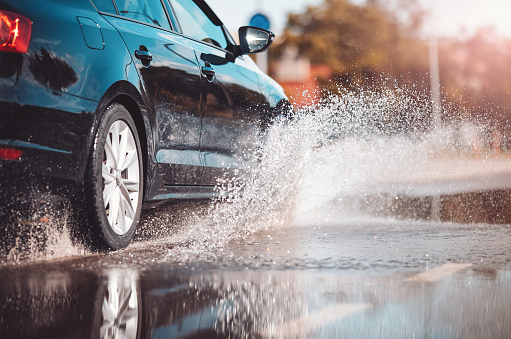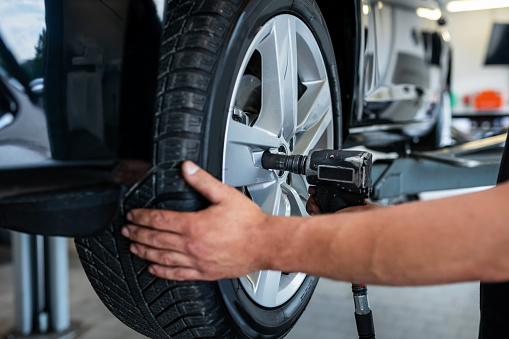May 19, 2025
HOW RAIN AFFECTS TIRES
Rain can affect tires in a few ways:
- Traction: When it rains, the road surface can become slippery, reducing the tire’s ability to grip the road. This can result in reduced traction and longer stopping distances, which can increase the risk of accidents.
- Hydroplaning: Hydroplaning occurs when a layer of water builds up between the tire and the road surface, causing the tire to lose contact with the road. This can cause the vehicle to lose control and skid.
- Wear and Tear: Driving on wet roads can cause more wear and tear on tires than driving on dry roads. The water can cause the rubber to degrade faster and increase the risk of punctures.
To minimize the impact of rain on tires, it’s important to make sure that your tires are in good condition, properly inflated, and have adequate tread depth. Additionally, it’s important to drive at a slower speed and to avoid sudden stops and sharp turns when driving on wet roads.

HYDROPLANING
Hydroplaning, also known as aquaplaning, occurs when a layer of water builds up between the tires of a vehicle and the road surface, causing the tires to lose contact with the road. This can result in a loss of control of the vehicle and a potential accident.
When a vehicle is traveling on wet roads, the water can accumulate in front of the tires, creating a thin film of water that the tires cannot easily push aside. This water film can cause the tires to ride up on top of the water, losing contact with the road surface.
Hydroplaning is more likely to occur at higher speeds, in heavy rain, and when the tires have low tread depth. Bald or worn-out tires are particularly susceptible to hydroplaning. The risk of hydroplaning can also be increased by poor tire maintenance, such as under-inflation or overloading the vehicle.
To prevent hydroplaning, it’s important to maintain good tire condition by keeping tires properly inflated, replacing worn tires, and ensuring that tires have adequate tread depth. Additionally, it’s important to reduce speed when driving in wet conditions, avoid sudden braking or acceleration, and avoid driving through puddles or standing water on the road.
TIRE PRESSURE
Tire pressure is the amount of air pressure inside a tire, measured in pounds per square inch (PSI) or kilopascals (kPa). Maintaining the correct tire pressure is important for a number of reasons:
- Safety: Properly inflated tires are better able to maintain contact with the road surface, which improves traction, handling, and braking. Underinflated tires can cause the tire to overheat and fail, which can lead to a blowout and potentially cause an accident.
- Fuel economy: Properly inflated tires can improve fuel economy because they reduce rolling resistance, which means the vehicle requires less energy to move forward. This can result in better gas mileage and reduced fuel costs.
- Tire wear: Overinflated or underinflated tires can cause uneven wear patterns, which can result in premature tire wear and the need for replacement sooner than expected.
To determine the correct tire pressure, consult the vehicle’s owner’s manual or the tire manufacturer’s recommendations. Tire pressure should be checked regularly, at least once a month, and before long trips. It’s also important to check tire pressure when the tires are cold, as driving even a short distance can increase tire pressure and give an inaccurate reading.
To check tire pressure, use a tire pressure gauge to measure the pressure in each tire and add or release air as needed to achieve the recommended pressure. It’s also a good idea to visually inspect tires for any signs of damage or wear.
TREAD DEPTH

Tread depth refers to the depth of the grooves in the tire’s tread pattern. The depth of the tread grooves is important for maintaining proper traction and handling, particularly in wet or slippery conditions.
The legal minimum tread depth for tires varies by country and region, but in general, a tire is considered legally worn out when the tread depth is less than 1.6mm. However, it’s recommended to replace tires before they reach this minimum legal limit to ensure adequate safety and performance.
The depth of the tire’s tread grooves can be measured using a tread depth gauge, which is a simple tool that measures the depth of the tire tread in millimeters or 32nds of an inch. Tread depth can also be estimated using the “penny test” or “quarter test”, where a penny or a quarter is inserted into the tread groove with Lincoln’s head facing down. If the top of Lincoln’s head is visible, the tire’s tread is too shallow and needs to be replaced.
Driving on tires with worn-out or shallow tread depth can increase the risk of hydroplaning, reduced traction, and longer stopping distances, which can increase the risk of accidents. It’s important to regularly inspect tires for signs of wear and to replace them when the tread depth is below the recommended level.
AVOIDING HYDROPLANING
Hydroplaning occurs when your vehicle’s tires lose contact with the road due to the buildup of water on the road surface. This can result in a loss of control of the vehicle and lead to accidents. Here are some tips to avoid hydroplaning:
- Slow down: Reducing your speed can help your vehicle maintain better contact with the road. This reduces the chances of hydroplaning.
- Check your tires: Ensure that your tires are properly inflated and have adequate tread depth. Worn out tires with shallow tread depth are more likely to hydroplane.
- Avoid puddles: Try to avoid driving through large puddles or standing water on the road.
- Avoid sudden movements: Avoid sudden braking, accelerating, or turning which can cause your vehicle to lose traction and hydroplane.
- Use cruise control wisely: Do not use cruise control in rainy or wet conditions. This can make it difficult to maintain control of the vehicle.
- Follow the tracks: Drive in the tire tracks of the vehicle ahead of you. These tracks are typically drier and have better traction.
- Be extra cautious in heavy rain: When driving in heavy rain, reduce your speed even further and be extra cautious.
By following these tips, you can help reduce your chances of hydroplaning and stay safe on the road.
Does water affect good tires?
-
Tire Material & Water: Tires are made of rubber compounds designed to withstand water exposure. Water alone doesn’t degrade or harm the tire rubber significantly.
-
Performance on Wet Roads: Water on the road can reduce tire traction due to hydroplaning (when a layer of water comes between the tire and the road). Good tires have tread patterns and rubber compounds designed to channel water away and maintain grip, improving safety.
-
Long-Term Exposure: Constant exposure to water combined with things like road salts, oils, or chemicals can eventually affect tires, but clean water alone is not harmful.
-
Maintenance Tip: After driving on wet or salty roads, washing tires can help remove residues that might degrade the rubber or rims over time.
Bottom line: Water won’t damage good tires, but your tires’ ability to handle water on the road is crucial for safety. That’s why investing in quality tires with good wet traction is important.
